Dog bites are a serious yet often misunderstood public safety issue in the United States.
Each year, millions are bitten, some fatally, and while hospitalizations and insurance claims continue to rise.
Between 2010 and 2024, data shows hundreds of deaths and growing medical costs.
This report explores where attacks occur most, which breeds are involved, and their lasting human and financial impact.
Table of Contents
- Dog Bite Statistics
- US Dog Bite Fatalities
- Dog Bite Fatalities by Breed
- Top 10 U.S. States for Fatal Dog Attacks
- Dog Bite Fatalities by Age Group
- The Growing Dog Population
- Reported vs. Underreported Dog Bites
- The Medical Impact of Dog Bites in the United States
- Dogs as Deadly Creatures
- Dog Bite Force
- Understanding and Preventing Dog Bite Tragedies
Key Takeaways: Dog Bite Statistics
- 4.5 million dog bites occur annually in the United States — that’s 12,300 per day or one every seven seconds.
- Roughly 885,000 people seek medical care each year, with 395,000 emergency room visits reported in 2022 – the highest number to date.
- 2.5% of ER patients are hospitalized, totaling around 9,000–10,000 hospital stays per year.
- The average hospitalization cost for a dog bite is $18,200, roughly 50% higher than for other injuries.
- 81% of bites require no medical care, yet more than 850,000 victims per year still need treatment for infection or reconstructive repair.
- Between 2010 and 2023, there were at least 593 fatal dog attacks. An average of 30–40 deaths per year, representing less than 0.001% of total bites.
- Pit bulls and rottweilers were involved in the majority of fatal cases (over 70% combined), with multi-dog attacks rising sharply since 2020.
- Children under 5 and adults over 65 face the highest fatality risk, accounting for most deaths between 2010 and 2023.
- California (63 deaths) and Texas (54 deaths) lead the nation in fatal attacks, followed by Florida, Georgia, and North Carolina.
- Globally, dogs cause 25,000–35,000 human deaths annually, mostly from rabies transmission, making them the 3rd deadliest animal worldwide.
- The strongest verified bite force among domestic dogs is 328 PSI (Rottweiler) — far below viral claims of “700+ PSI for the Kangal dogs.”
- Dog bite insurance claims reached $1.57 billion in 2024, with 22,658 claims and an average payout of $69,272.
- California, Florida, and Texas record the highest number and cost of insurance claims.
- Rural areas experience 4× higher dog bite injury rates than urban ones, reflecting gaps in animal control and access to care.
US Dog Bite Fatalities
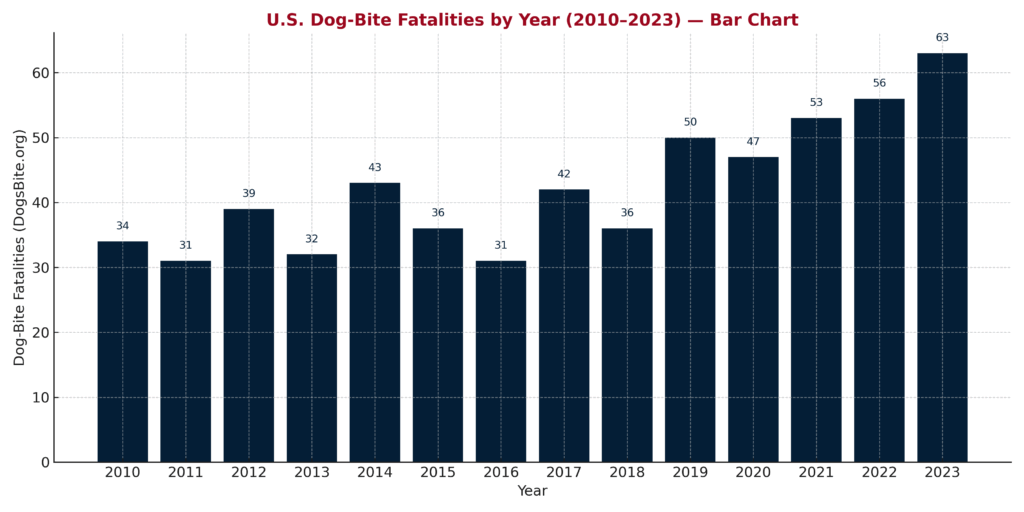
Dog Bite Fatalities by Breed
- Total fatalities: At least 593 fatal dog attacks were documented in the United States between 2010 and 2023.
- Pit bulls: Involved in approximately 406 deaths (68%).
- Rottweilers: Linked to 26 deaths (4%).
- Mixed-breed dogs: Accounted for 12 deaths (2%).
- Other breeds occasionally linked to fatalities:
- German Shepherds – 8 deaths
- American Bulldogs – 6 deaths
- Mastiffs – 3 deaths
- Huskies – 1 death
- German Shepherds – 8 deaths
- Multi-dog or multi-breed attacks have become increasingly common, representing up to 64% of fatal incidents in 2022.
- Consensus: Breed alone does not determine aggression, owner behavior, training, and neglect are the leading factors in most severe and fatal attacks.
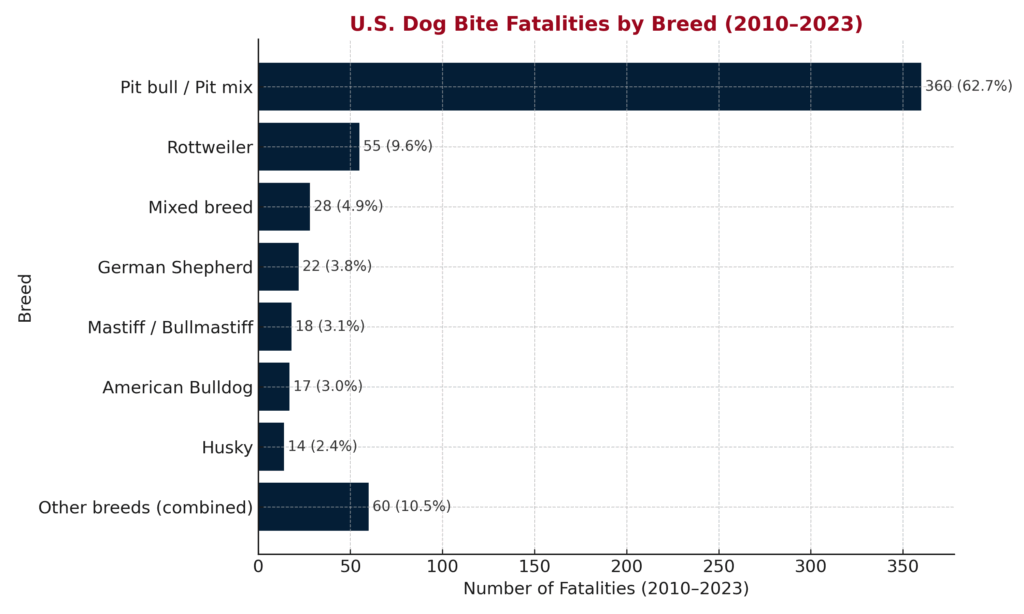
Where Do Fatal Dog Attacks Happen Most Often?
Top 10 U.S. States for Fatal Dog Attacks (2005–2023)
Dog bite fatalities occur across the United States, but certain states consistently record higher numbers of deadly attacks.
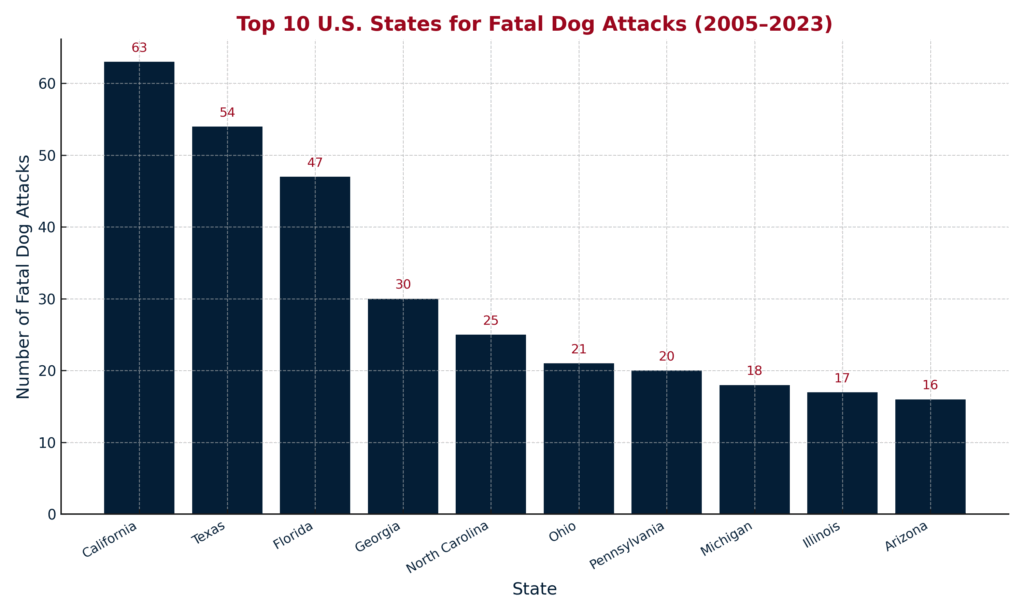
Data from DogsBite.org and the CDC WONDER database show that California and Texas have reported the most dog bite–related deaths over the past two decades, followed by Florida, Georgia, and North Carolina.
| Rank | State | Fatal Dog Attacks |
|---|---|---|
| 1 | California | 63 |
| 2 | Texas | 54 |
| 3 | Florida | 47 |
| 4 | Georgia | 30 |
| 5 | North Carolina | 25 |
| 6 | Ohio | 21 |
| 7 | Pennsylvania | 20 |
| 8 | Michigan | 18 |
| 9 | Illinois | 17 |
| 10 | Arizona | 16 |
Together, California and Texas account for more than one-fifth of all U.S. dog bite fatalities recorded since 2005.
Experts attribute these higher numbers to a combination of factors, including population size, climate, urban sprawl, and higher rates of unneutered or poorly restrained dogs.
The Southeast and Southwest regions report the majority of fatal dog attacks, while the Northeast remains relatively low by comparison.
In many cases, victims are children or elderly adults, and incidents often involve multiple dogs or large, powerful breeds.
Despite increasing awareness, reporting and classification gaps continue to affect national fatality data.
Official CDC figures often exceed nonprofit counts, suggesting that the true number of fatal dog attacks may be higher than published totals.
Why State Laws Matter in Dog Bite Cases
Understanding where dog bite fatalities occur most often is only part of the picture.
What truly matters for victims and families is how each state handles liability for dog attacks and those laws can vary dramatically.
Some states, such as California and Florida, have strict liability laws, meaning a dog owner is automatically responsible if their dog bites or kills someone, regardless of prior behavior or the owner’s knowledge of aggression.
Other states, including Texas and North Carolina, follow a “one-bite rule,” which requires victims to prove that the owner knew or should have known their dog was dangerous before the attack occurred.
These differences can significantly affect a victim’s ability to recover compensation for medical bills, reconstructive surgery, emotional trauma, and wrongful death.
Factors such as leash law violations, landlord negligence, and owner recklessness can also determine who is legally accountable.
Because of these variations, working with an experienced dog bite attorney is critical after a serious or fatal attack.
A dog bite lawyer familiar with state-specific dog bite statutes can help gather evidence, navigate liability rules, and pursue full compensation for victims and families affected by these preventable tragedies.
Dog Bite Fatalities by Age Group
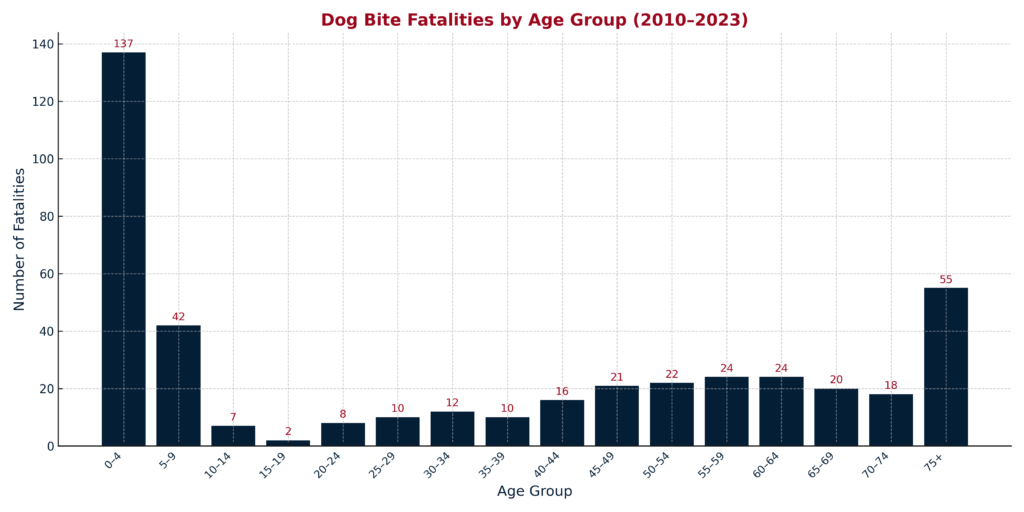
Dog bite fatalities impact victims of all ages, but the data shows that the youngest and oldest Americans are most at risk of deadly attacks.
Between 2010 and 2023, the majority of fatal dog bites occurred among children under five and adults over 65.
The groups that are physically smaller, less able to defend themselves, and more likely to suffer severe trauma when attacked.
- Children ages 0–4 accounted for the largest share of fatalities, with at least 137 deaths, roughly one in every three fatal attacks during this period.
- The elderly (75+) experienced another significant concentration, with 55 deaths. Seniors often face increased risk due to limited mobility, slower reaction time, and more fragile health.
- Fatalities decline through adolescence and early adulthood, reaching the lowest counts among pre-teens (10-14) and teens (15–19).
- Rates begin to rise again steadily in middle age (40–64), likely reflecting increased exposure to dogs in domestic and occupational settings.
These patterns underscore a clear reality: children and seniors remain the most vulnerable populations in serious and fatal dog attacks.
For families, prevention means more than supervision. It means ensuring dogs are socialized, secured, and properly trained to prevent catastrophic outcomes.
The Growing Dog Population
As the number of dogs in American homes rises, so does the potential for dog bite incidents.
The American Veterinary Medical Association (AVMA) 2024 Sourcebook reports there are 89.7 million dogs in the U.S., up from 80.1 million in 2023.
Likewise, the 2025 APPA National Pet Owners Survey found approximately 68 million dog-owning households, a record high.
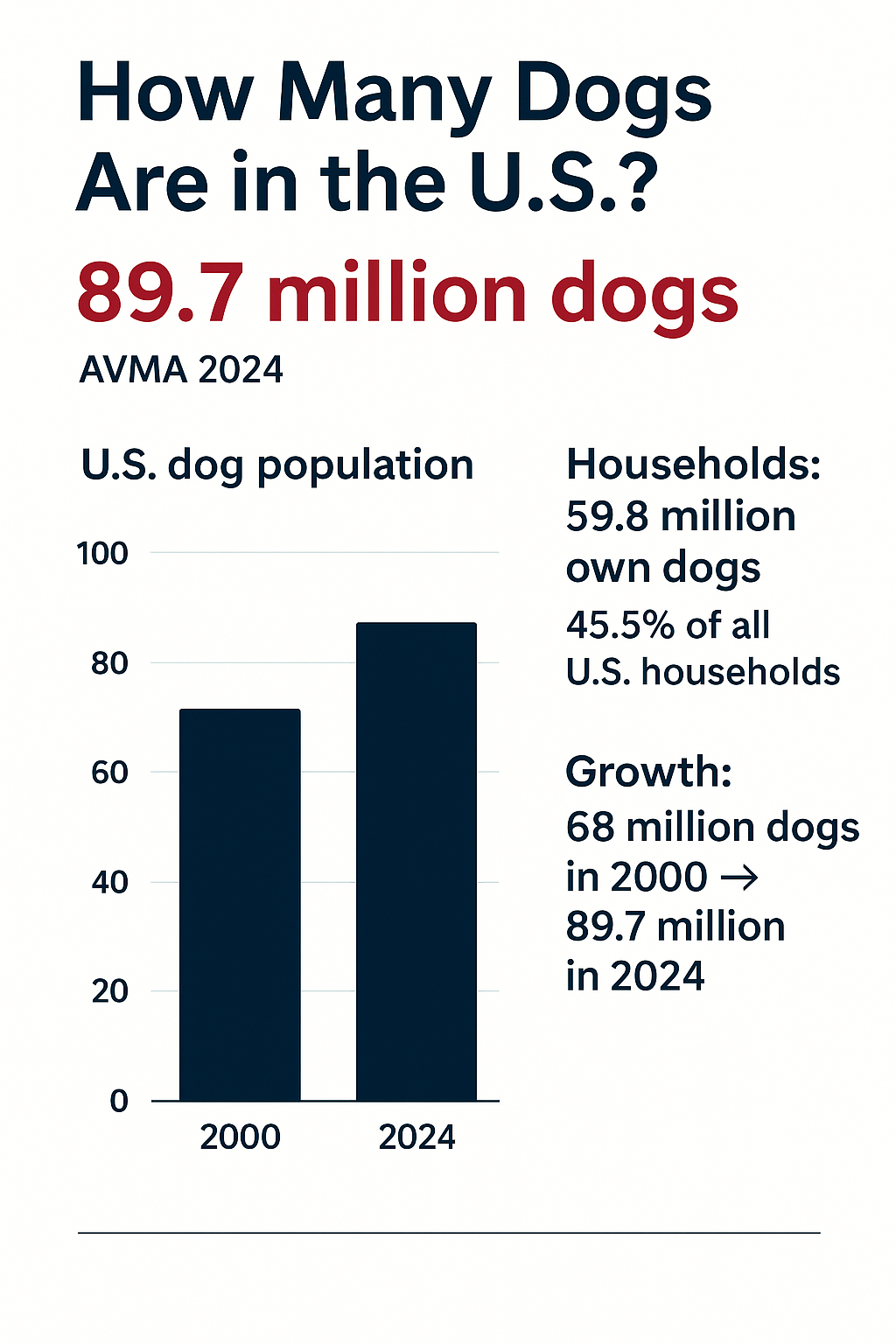
With nearly one in two households now owning a dog, understanding the risks and the rights of dog bite victims has never been more important.
Reported vs. Underreported Dog Bites
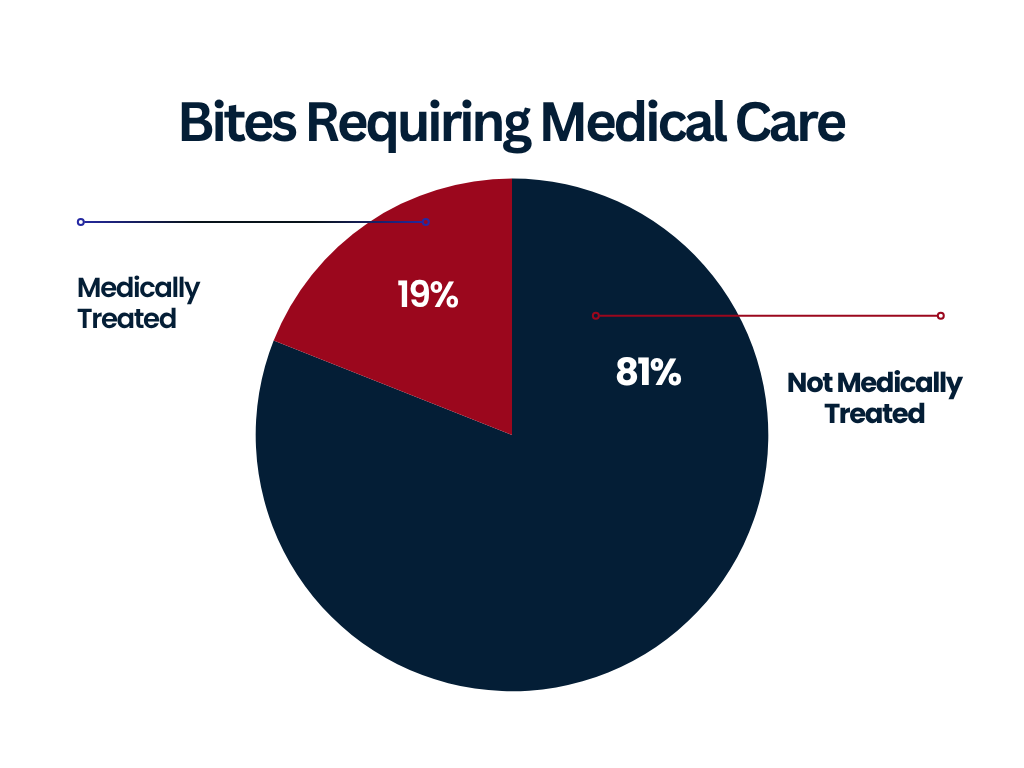
Dog bite incidents are significantly underreported in the United States.
Studies show that an estimated 81% of all dog bites do not require medical care, meaning the majority go unreported to health authorities.
Based on national estimates, roughly 4.5 million dog bites occur each year, yet only about 885,000 people seek medical attention and fewer than 400,000 are treated in emergency departments.
This means that only about one in five dog bite incidents (19%) ever enters the medical or legal record system.
The Medical Impact of Dog Bites in the United States
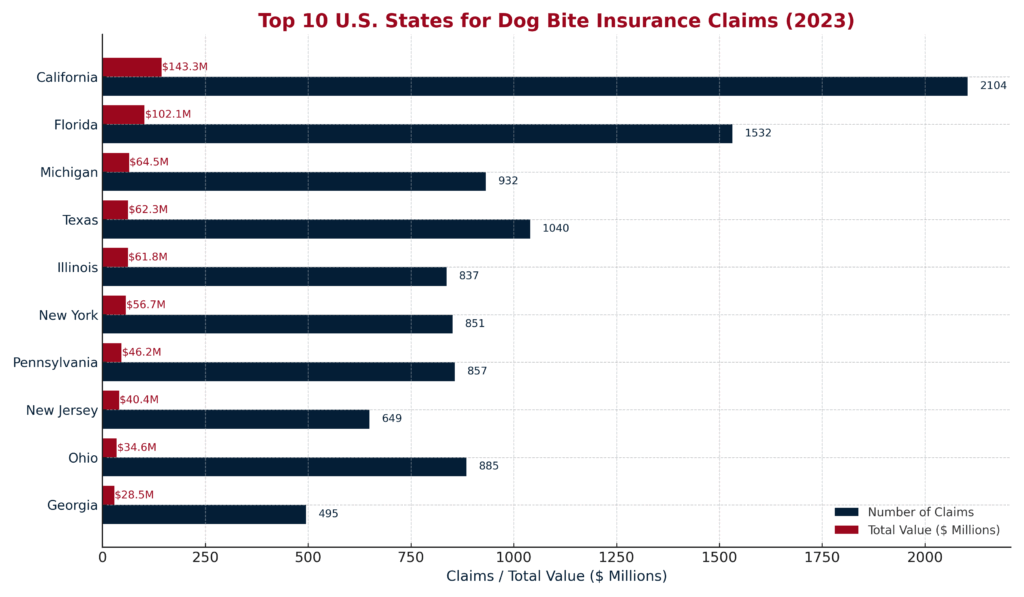
Dog Bite Medical Stats
- 395,036 people were treated in emergency departments for dog bites in 2022, the highest total ever recorded.
- That equals 1,082 ER visits per day, or roughly 45 every hour.
- Around 885,000 Americans seek medical care for dog bites each year.
- About 2.5% of ER visits lead to hospitalization, nearly 10,000 hospital stays annually.
- The average cost of a hospital stay for a dog bite is $18,200, about 50% higher than the average injury-related stay.
- Roughly 81% of all bites don’t require professional medical treatment, yet 850,000 victims per year still need medical care.
- 18,917 reconstructive surgeries were performed in 2022, down from over 30,000 in 2009.
- 65–80% of severe bites in children involve the head and neck, often requiring surgical repair.
- Infection occurs in 10–20% of dog bite wounds, with higher risk from unvaccinated or stray dogs.
- Rural residents experience dog bite injury rates four times higher than those in urban areas.
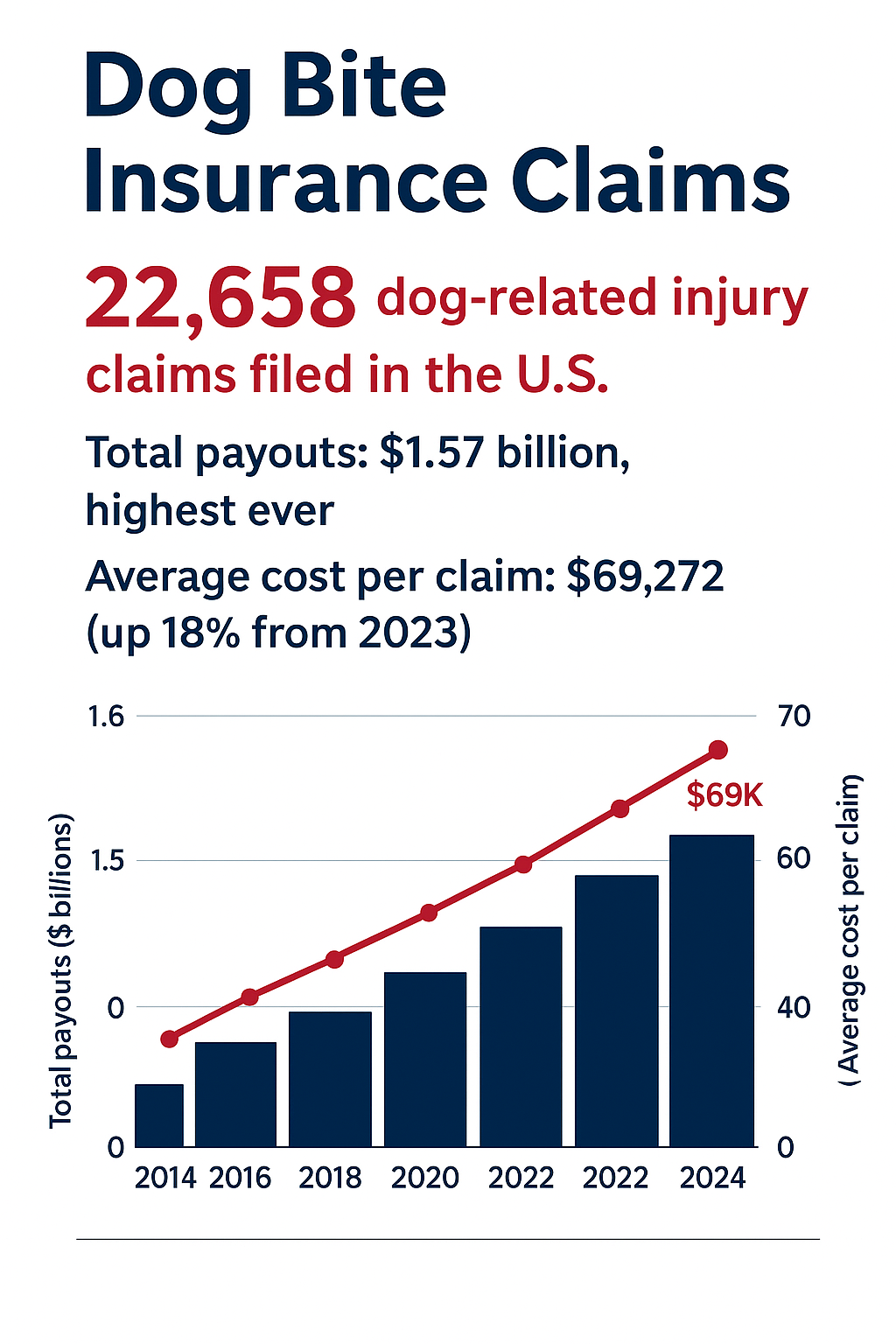
Dogs as Deadly Creatures
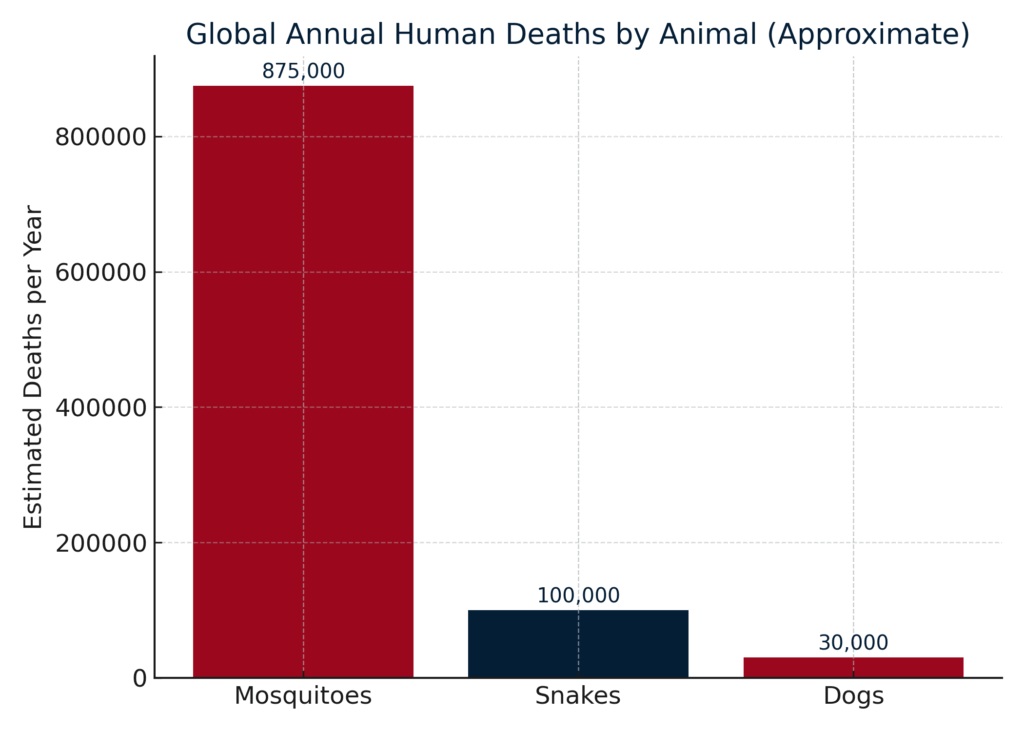
While dogs are often called “man’s best friend,” they also rank among the world’s deadliest animals when it comes to human fatalities primarily due to the transmission of rabies.
Globally, dogs are estimated to cause around 30,000 human deaths each year primarily from rabies, placing them third on the list of the deadliest animals on Earth.
Global Comparison of Annual Human Deaths by Animal
- Mosquitoes: 875,000 deaths
- Snakes: ~100,000 deaths
- Dogs: 30,000 deaths (primarily from rabies)
Despite their reputation as loyal companions, these numbers underscore the importance of responsible ownership, vaccination programs, and bite prevention education.
Dog Bite Force: Separating Facts from Myths
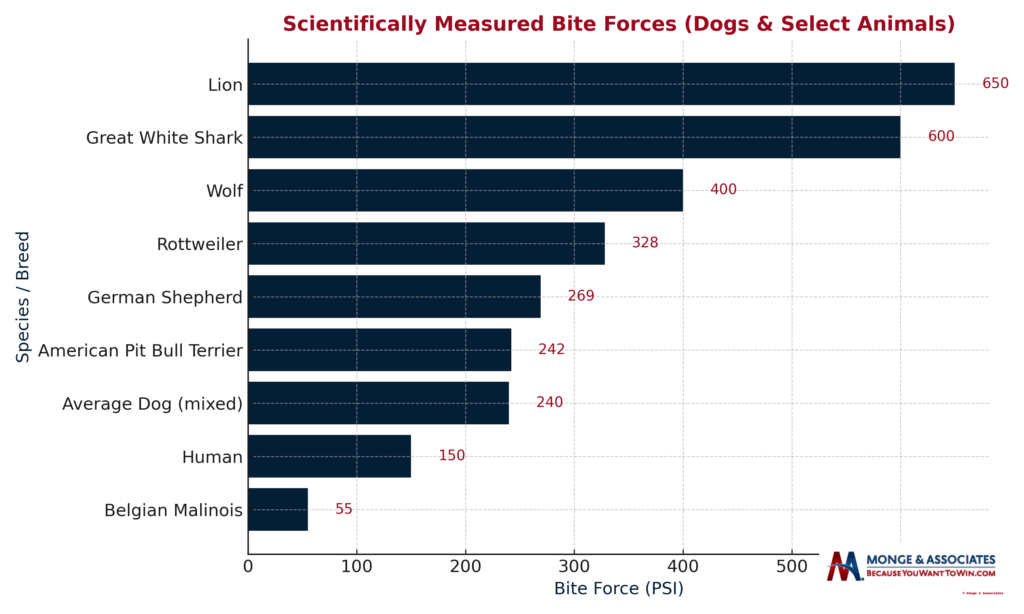
When it comes to dog attacks, few statistics are as misunderstood or exaggerated as bite force.
Many viral charts and online claims suggest that certain breeds can exert over 700 PSI (pounds per square inch) but most of these figures have no scientific basis.
In reality, only a handful of dog breeds have ever been scientifically measured for bite force, and the results are far lower than internet myths suggest.
| Breed | Measured Force |
|---|---|
| Rottweiler | 328 PSI |
| German Shepherd | 238–269 PSI |
| American Pit Bull Terrier | 235–242 PSI |
| Belgian Malinois | 247 N (≈55 lbf) — functional bite, not PSI |
| Average Dog (mixed breeds) | 230–250 PSI |
Important Note: The Belgian Malinois study measured bite force in Newtons (N) — not PSI — during training bites, not maximum strength. Because Newtons measure force and PSI measures pressure, these units cannot be directly compared without knowing the contact area.
Understanding and Preventing Dog Bite Tragedies
Dog bites remain one of the most preventable public safety threats in the United States.
While the majority of bites cause minor or no injury, tens of thousands of Americans each year face lasting physical, emotional, and financial consequences and hundreds lose their lives.
Between 2010 and 2024, more than 590 fatal dog attacks were recorded nationwide, with children and seniors representing the most vulnerable victims.
The data tells a clear story: incidents are rising alongside the growing dog population, and the costs, both human and economic, continue to climb.
From rising emergency room visits to $1.5 billion in annual insurance claims, the impact of dog bites extends far beyond the immediate trauma of an attack.
Ultimately, breed alone doesn’t define aggression, owner responsibility, training, socialization, and proper restraint do.
With stronger education, consistent enforcement of leash laws, and awareness of high-risk factors, many of these injuries and fatalities could be avoided.
Dog ownership comes with profound rewards, but also real responsibilities.
Recognizing the risks is the first step toward prevention, accountability, and safer communities for people and pets alike.
Sources & References
- Gilchrist J. et al., “Dog Bites: Still a Problem?” Injury Prevention (2008)
- CDC, “Nonfatal Dog Bite-Related Injuries Treated in Hospital Emergency Departments — United States, 2001” (MMWR, 2003)
- DogsBite.org, U.S. Dog Bite Fatality Data & Breed Analysis
- AVMA, Dog Bite Prevention Resource Center
- American Society of Plastic Surgeons, 2022 Reconstructive Surgery Statistics Report
- “Reliability of a New Bite Force Measure and Biomechanics of Modified Long Attack in Police Dogs” (Hyytiäinen et al., 2021)
